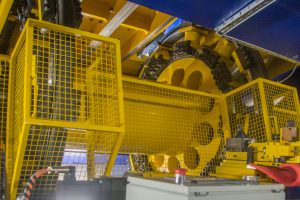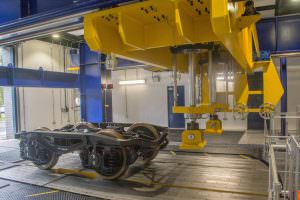A £4.5 million rail research lab has opened in Huddersfield in the UK.
At a ceremony on 12 October, Richard East, IMechE Railway Division chairman, formally opened the University of Huddersfield’s Railway Research Laboratory, which is part of the University’s Institute of Railway Research (IRR).
The facility was funded by the Regional Growth Fund, RSSB, Unipart Rail, Omnicom and the National Skills Academy for Rail (NSAR).
The laboratory includes a six-axis hexapod motion platform and high performance computing system for big data analysis. However, its most impressive facility is a unique full-scale bogie rolling contact, adhesion and braking test rig. This has a 2-metre diameter rotating rail drum driven by a 0.5 MW hydraulic motor which can test a bogie at up to 125 mph and apply a braking torque of 110 kNm.
Part of the rig is a dynamic test cell which can apply loads of upto 50 tonnes on the bogie or to any other component. Indeed, the rig’s first use will not use the roller. Instead the dynamic rig only will be used for accelerated fatigue testing of slab track. This will be subject to variable loads to simulate the passage of trains will be applied over a 30-day period.
Dr Paul Allen, the IRR’s assistant director explains that the rig was not designed for specific tests as the intention was to make it as flexible as possible. He advised that securing funding from the Regional Growth was demanding as they had to be convinced that the rig would generate jobs, both at the university and in the supply chain.
Speaking at the ceremony, vice chancellor Professor Bob Cryan noted that this £4.5 million facility is the university’s largest ever purchase and that with 95 piles, and £100,000 worth of air springs to isolate the 150-tonne rig from adjacent delicate scientific equipment, the hole for the rig must have been the most expensive in the region.
The rig was designed and built by Heinrich Georg, which specialises in custom-built special purpose equipment.
Report by David Shirres





